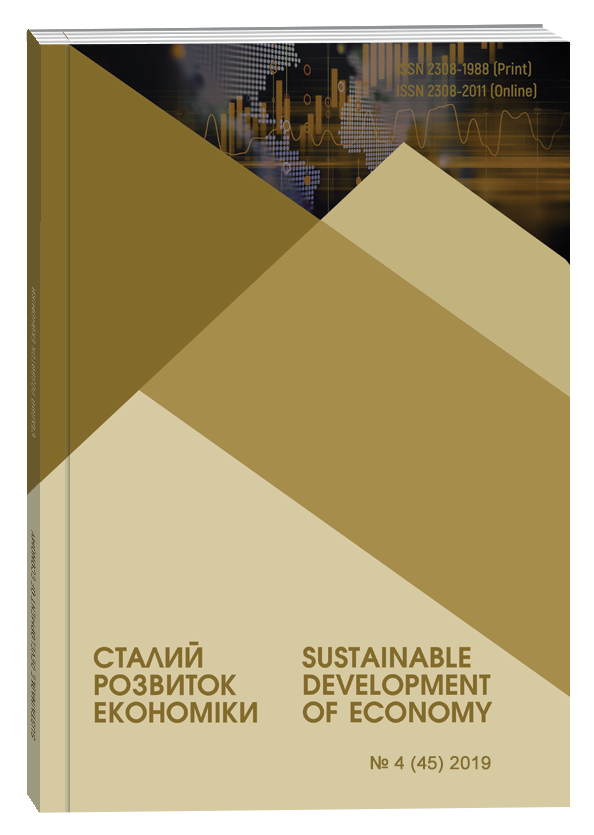FEATURES OF INFORMATION FLOWS OF AGRARIAN ENTERPRISES
Abstract
Purpose. The aim of the article is determination of the main information flows of agricultural enterprises, taking into account the peculiarities of the production process. Methodology of research. The article used general scientific and special methods of research, in particular the following: dialectics and scientific abstraction – in the course of interpretation of the essence of the concept of “information flow”; induction and deduction – in the course of the study of the peculiarities of the organization of providing structural units with relevant information; analysis, synthesis, systematic approach and grouping – in the course of classification of information flows of the enterprise and their characteristics; graphic – for visual representation of the basic model of internal information flows of the agrarian enterprise. Findings. The essence of the concept of «information flow» is defined and it is proposed to consider it as a set of communication ways and channels of the enterprise for purposeful and organized transfer of a certain amount of external and internal information. The peculiarities of providing the relevant information of the basic structural units, namely: administration, production and service units, marketing and marketing department, planning and financial service, are substantiated. Originality. The basic model of internal information flows of agrarian enterprise is developed taking into account the peculiarities of the production process, and it is substantiated that the model participants simultaneously act as both objects of data generation and their consumers. Practical value. The key features that can be used for optimization of information flows are considered, taking into account the sectoral features that directly affect the specifics of the formation and the efficiency of their functioning. It is proposed to create a corporate information portal, implemented with the help of WEB-technologies, to create a single point of access and information flow management, to increase the efficiency of making effective management decisions, to expand the marketing and presentation network of the enterprise presentation and communications.
References
Кальченко А.Г., Кривещенко В.В. Логістика: навч. посібник. Вид. 2-е. Київ: КНЕУ, 2008. 472 с.
Чіхрай В.В. Побудова економічної моделі процесу створення інформаційної системи підприємства. URL: http://www.rusnauka.com/7_NND_2009/Economics/43098.doc.htm (дата звернення: 11.11.2019).
Птіцина Л.А. Основні підходи до управління інформаційними потоками бізнес діяльності промислових підприємств України: формування єдиного інформаційного забезпечення системи управління промисловим підприємством в складних ринкових умовах. Вісник економічної науки України. 2010. № 2. С. 121-124.
Сорокіна О.С. Родові характеристики поняття «інформація». Гілея. 2009. № 27. С. 323-335.
Малімон В.І. Комунікаційна політика в діяльності державного службовця: навч. посібник. 2-ге вид. доп. і розш. Івано-Франківськ: Місто-НВ, 2008. 344 с.
Захарченко А.П. Загальні принципи аналізу інформаційних потоків у Інтернеті. Наукові записки Інституту журналістики. 2010. Т. 41. С. 80-85.
Карачарова К.А. Класифікація інформаційних потоків автотранспортних підприємств. Вісник економіки транспорту і промисловості. 2011. № 33. С. 88-93.
Мізюк Б.М. Інформаційна природа управління. Економіка та держава. 2012. № 2. С. 8-13.
Іванова О.М. Характеристика та класифікація інформаційних потоків підприємств. Інвестиції: практика та досвід. 2016. № 13. С. 18-22.
Kalchenko, A.H. and Kryveshchenko, V.V. (2008), Lohistyka [Logistics], tutorial, 2nd ed., КNЕU, Kyiv, Ukraine, 472 p.
Chikhrai, V.V. “Building an economic model of the process of creating an enterprise information system”, available at: http://www.rusnauka.com/7_NND_2009/Economics/43098.doc.htm (access date November 11, 2019).
Ptitsyna, L.A. (2010), “Basic approaches to information management business of industrial enterprises of Ukraine: the formation of a single information support system of industrial enterprise in difficult market conditions”, Visnyk ekonomichnoi nauky Ukrainy, no. 2, pp. 121-124.
Sorokina, O.S. (2009), “Generic specification the term "information"”, Hileia, no. 27, pp. 323-335.
Malimon, V.I. (2008), Komunikatsiina polityka v diialnosti derzhavnoho sluzhbovtsia [The communication policy of a public servant], tutorial, 2nd ed., Misto-NV, Ivano-Frankivsk, Ukraine, 344 p.
Zakharchenko, A.P. (2010), “General principles of analysis of information flow on the Internet”, Naukovi zapysky Instytutu zhurnalistyky, Vol. 41, pp. 80-85.
Karacharova, K.A. (2011), “The classification of information flows trucking companies”, Visnyk ekonomiky transportu i promyslovosti, no. 33, pp. 88-93.
Miziuk, B.M. (2012), “Information management nature”, Ekonomika ta derzhava, no. 2, pp. 8-13.
Ivanova, O.M. (2016), “Characterization and classification of information flows of enterprises”, Investytsii: praktyka ta dosvid, no. 13, pp. 18-22.


